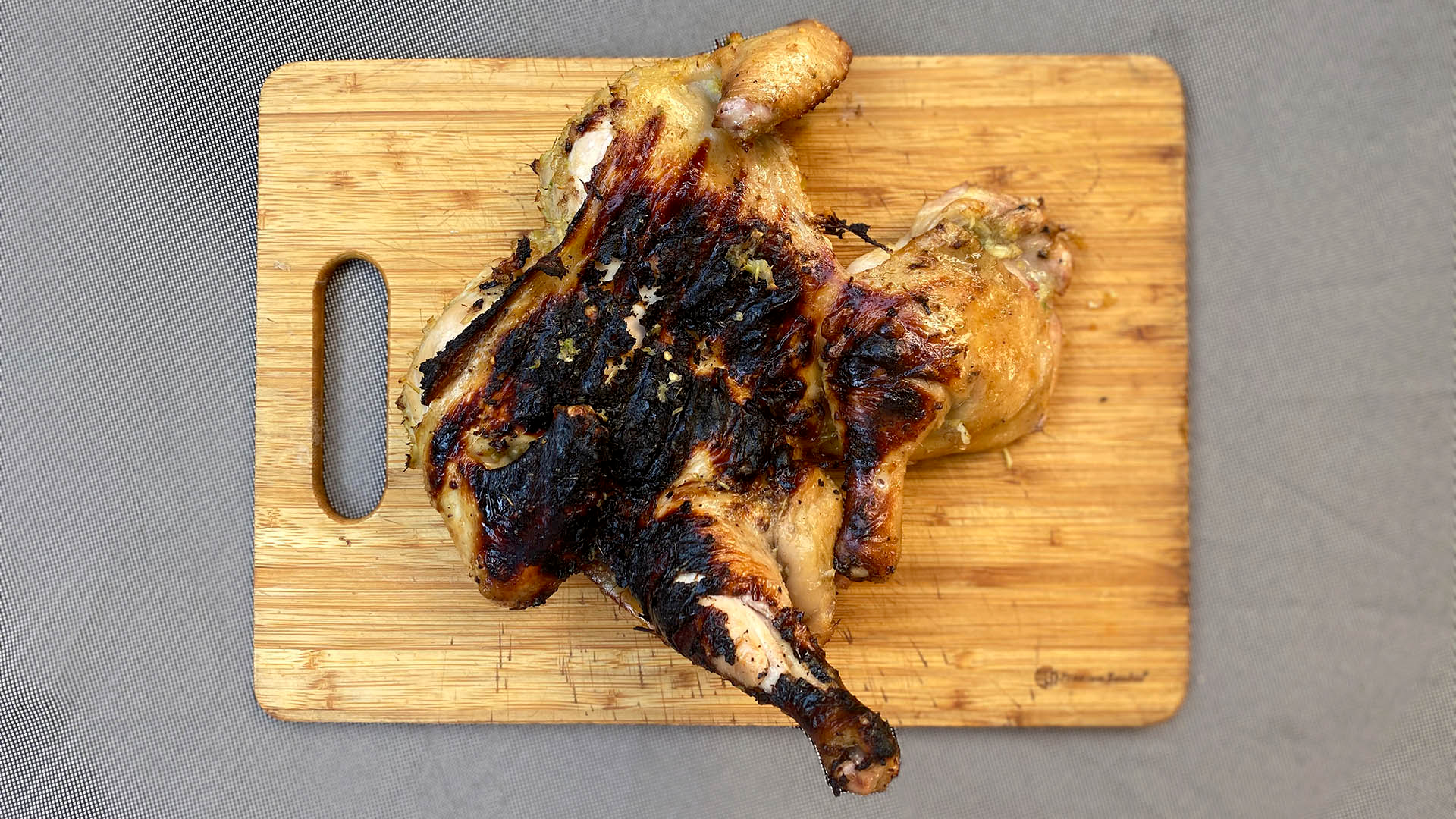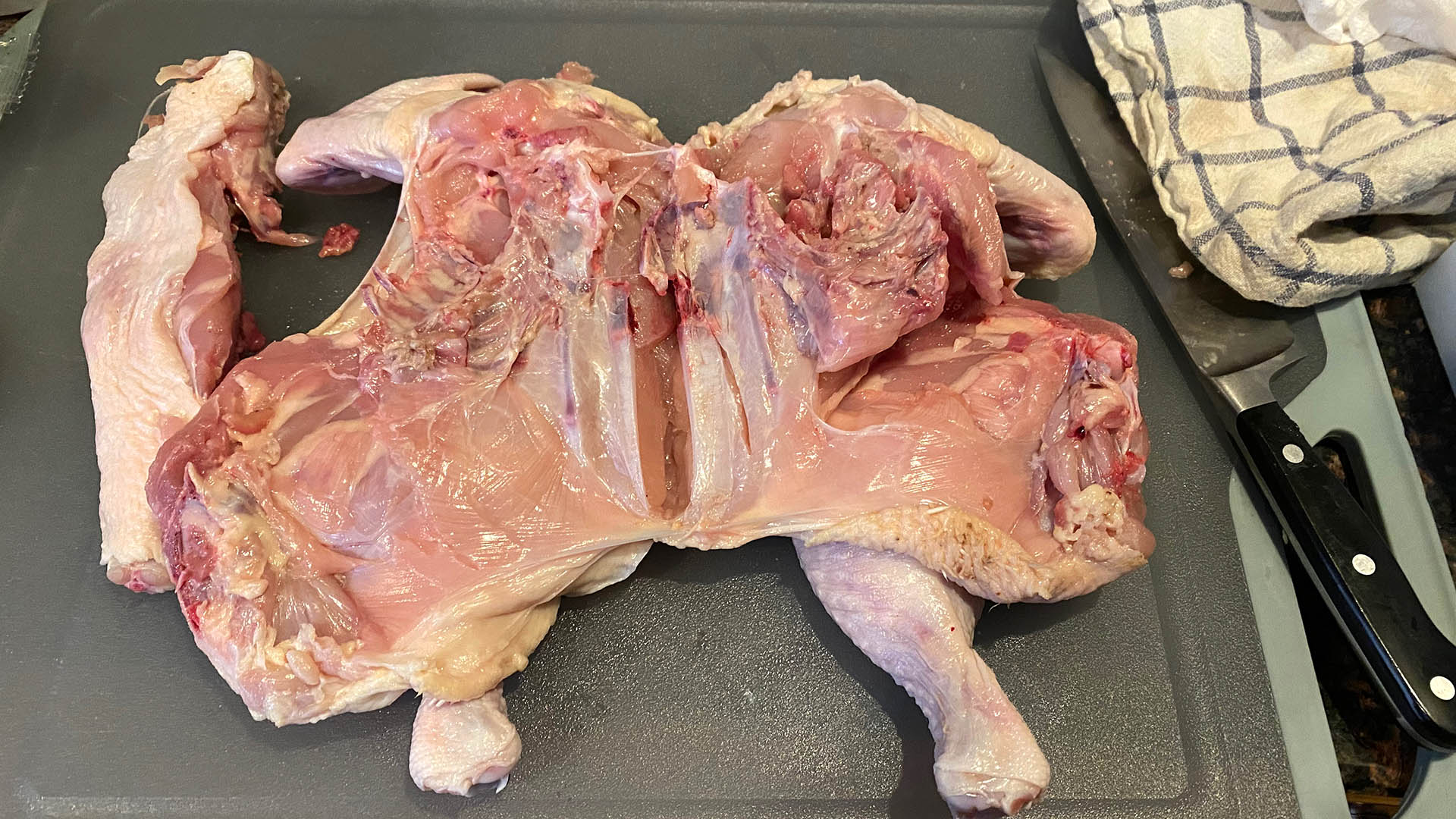The Very Best Way To Grill A Whole Chicken
An easy way to give off the illusion that you are an amazing cook is to prepare a whole animal. Specifically a chicken or a fish, which are small enough to roast or grill without special equipment but large enough to look impressive on a serving plate. The first time I roasted a whole chicken (using this recipe), I was so impressed with myself, I spent several minutes just staring at the skillet in awe. But then I realized—it wasn't that I am such a great cook, it's just that cooking a whole chicken is really not that hard.
Still, people are impressed. And as time has gone by, I've been trying new methods. I acquired a charcoal grill a few years back, and my repertoire expanded. Now I think I have hit on the absolute perfect method for grilling a whole chicken. It leaves the chicken tender and juicy throughout without the stringy undercooked meat around the bones that makes people hate chicken. It is also very easy and reliable and, like the best grilling recipes, gives you plenty to time to sit around and enjoy the outdoors. All you need is a good knife and a solid set of tongs, plus, of course, the chicken and a grill. And, finally, a tolerance for handling raw chicken.
The method comes from Cheers to the Publican, a cookbook published a few years ago by Paul Kahan, chef-owner at the Publican, Avec, Blackbird, and many other excellent restaurants in Chicago, with coauthors Cosmo Goss and Rachel Holtzman. Grilled chicken is the Publican's most famous dish, inspired, Kahan writes, by the chef at a Portuguese restaurant in Montreal "where this guy was grilling spiced and spatchcocked chicken over a charcoal grill—while smoking a cigarette." The Publican marinates its version in a mixture of lemon juice, olive oil, espelette pepper, brown sugar, garlic, and oregano, and while that is delicious, I've found that it's equally delicious with any other marinade you care to use.

The Best Grilled Chicken
The hardest part comes at the beginning: spatchcocking and deboning the chicken. If you're not feeling up to it, there's no shame in asking your butcher to do this for you. But if you want to hone those knife skills, here's how to do it. (Warning: photos of raw chicken ahead, if that makes you squeamish.)
First pat your chicken dry with paper towels. Next, cut off the wing tips with your knife or a pair of poultry shears. Then, use the knife or shears to slice alongside the chicken's backbone, first on one side, then the other. This will be a lot easier if your knife is sharp. Pull out the backbone and toss it in your stock bag. Open up the chicken like a book. Then turn it so the skin side is down.
Make a slice down the middle of the keelbone, the white piece in the center, and push down on the chicken's sides. The keelbone should pop out. If it does not, use your knife to scrape away at the bones and cartilage until you can pull it out.

Next, scrape away at the rib bones on each side, all the way to the wing joint, until the ribs come out, too. They are all connected by cartilage, so they should come out in one piece.

Finally, remove the thigh bones. Prod the meat on the thigh until you feel the bone, then slice through until the bone is visible, up to the knee joint, where it connects to the drumstick. Stab your knife right into the middle of the joint and twist until the bones pop apart. Then, use your knife to scrape the meat away from the bone. There may be some pieces of rib bone if you didn't cut right through the joint when you were removing the backbone. Chop those off, too, and put it all in the stock bag.
And there you go! A beautiful boneless chicken! If you can't quite visualize it in your mind, here's a video to help. You don't have to debone the legs, unless you feel super fancy.
Note: This guy makes it look very easy. This is because he is a butcher and has spent his working life taking dead animals apart. If you are an amateur like me, you will make a lot of unnecessary cuts and may accidentally slice off pieces of meat. That is okay! Just do the best you can, and if the chicken slices are big enough, dunk them in the marinade and grill them, too. They make a good snack.

If you don't mind waiting an extra day to cook and eat the chicken, here's an easy trick to crisp up the skin: sprinkle salt over the whole bird, cover it loosely with plastic (I usually stick the whole plate inside a plastic grocery bag), and put it in the fridge overnight. This is an old trick invented by Judy Rodgers at the Zuni Cafe (and independently discovered by Samin Nosrat) that dries out the chicken.

The morning of the day you plan to grill your chicken—or, let's be honest, the afternoon—make your marinade. (We've got a good one right here.) Then give your chicken a nice bath in it, massaging the marinade all over the meat and the skin. Some people like to put their chicken in a nonreactive bowl, covered in plastic wrap. Other people like to put it in a zip-top bag. You do whichever makes you happy. If you're going to be grilling within the next hour or so, leave the chicken out on the counter. Otherwise, pop it in the fridge and take it out about an hour before you plan to start grilling.
Light your grill. If you've got a gas or propane grill, you'll only need to heat up one side. If you're using charcoal, shove the briquettes off to one side once they're hot. Clean and oil up your grate. Now you're ready to go!

Plop the chicken on the cooler side of the grill, skin side down, the ends of the drumsticks facing the heat. Put the lid over the grill and let the the chicken cook for 5 or 6 minutes, depending on how hot your fire is; you want a nice char, but you don't want to burn the hell out of it. Then, turn your chicken so the skin is still down but directly over the heat. Cook another 5 or 6 minutes.
Now it gets exciting! Flip the bird so that the meat side is down, and once again put its feet to the fire. Cook it for—yes!—5 or 6 minutes. Can you guess what the final step is? If you said, "Turn it so that the meat is over the direct heat and let it sit for 5 to 6 minutes," you win our grand prize. It's... a grilled chicken!
Once you've finished all the turning and flipping, test your chicken for doneness. If you use an instant-read thermometer, the temperature should be at least 160 degrees Fahrenheit. Or you can use more visceral methods, like cutting it open to see if the meat is cooked or (as Kahan suggests) stabbing the thigh or the breast with a paring knife and touching the blade to your arm to see if it's hot.
Let the chicken sit for 5 minutes. Then eat! The beauty of this is that you don't have to carve it. Just cut it up and chow down. Or tear it apart with your bare hands if you want. The leftovers are also excellent.

Lemongrass marinade
This is my absolute favorite marinade recipe. I found it on the internet about 10 years ago and copied it down. I haven't been able to find it again since, which I regret now because I would love to give proper credit to its inventor. It's very pungent, as you might expect from all the garlic and shallots, but the lemongrass gives it a nice tinge of sweetness.
- 4 (6-inch) stalks of lemongrass, cut crosswise into ½-inch pieces
- 10 garlic cloves, peeled
- 5 shallots, peeled and quartered
- 4 serrano chiles, cut into ½-inch pieces
- ½ cup water
- 2 tsp. salt
- 1½ tsp. fish sauce
- 3 Tbsp. olive oil
- 2 Tbsp. sugar
Toss everything into a blender or food processor and grind up until it resembles a paste. It will not be completely smooth. That's fine. Rub it over your chicken— or anything else for that matter.

